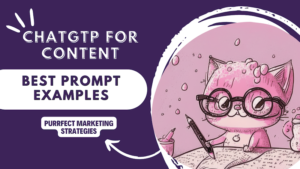In today’s article I will show you how to use ChatGPT to leverage your marketing efforts: from how to create a comprehensive marketing plan for your product or service to the copywriting of the content, email and social media associated with it.
How Chat GPT works technically for beginners.
ChatGPT is an AI model based on a deep learning technique called a transformer neural network. It’s trained on a vast amount of text data to learn patterns, language structures, and how words relate to each other. This training allows it to generate human-like responses when given input.
At its core, ChatGPT consists of a large neural network with millions of parameters. During the training process, the model learns to predict what comes next in a sentence based on the preceding context. It learns to associate certain words and phrases with specific meanings, allowing it to generate coherent responses.
To use Chat GPT, simply sign up at https://chat.openai.com/ and fire away your first question.
How to use Chat GPT to create a marketing plan.
Using ChatGPT to create a marketing plan can be a creative and helpful approach. Chat GPT can even help you create a business plan from scratch and it is a fantastic way to make money online.
Although ChatGPT can provide insights and suggestions, it’s important to remember that it’s an AI model and may not have specific domain knowledge or understand the intricacies of your business. Here’s a step-by-step guide on how to utilise ChatGPT to assist you in creating a marketing plan:
Clearly define your objectives: Before engaging with ChatGPT, outline your marketing goals and objectives. Determine what you aim to achieve through your marketing efforts, whether it’s increasing brand awareness, generating leads, driving sales, or something else.
Evaluate and iterate: Review the response generated by ChatGPT and assess its relevance and applicability to your marketing objectives. Extract the valuable insights or suggestions that align with your goals. If the response is not comprehensive or requires further clarification, you can iterate by asking follow-up questions to delve deeper into specific areas.
Combine human expertise: While ChatGPT can provide helpful insights, it’s beneficial to incorporate the expertise of marketing professionals or team members who have domain knowledge. Leverage their experience and insights to evaluate and refine the ideas generated by ChatGPT.
Create a cohesive marketing plan: Compile the insights, suggestions, and recommendations from ChatGPT and your team into a cohesive marketing plan. Define the strategies, tactics, target audience, messaging, and budget allocation based on the collected information. Ensure that the plan aligns with your overall business objectives.
If you manage a small team or you simply want to keep track of all the tasks needed when building your website, use my project management task tracker. It will help you a lot.
Implement, monitor, and adapt: Execute your marketing plan and closely monitor the performance of your marketing efforts. Continuously track the key performance indicators (KPIs) and adapt your strategies based on real-time data and insights gained from the implementation.
Examples of prompts.
Prepare guiding questions: To get the most relevant and useful responses from ChatGPT, formulate specific questions related to your marketing plan. For example:
“What are some effective marketing channels to reach our target audience?”
“What strategies can we employ to improve customer engagement and loyalty?”
“How can we differentiate our product/service from competitors?”
Engage in a conversation: Start a conversation with ChatGPT by providing one of your guiding questions. You can frame it as a dialogue, such as:
“As we develop our marketing plan, I’m curious to know your thoughts on effective marketing channels. What are some options we should consider?”
How to use Chat GPT to create social media content.
Chat GPT can be used for B2B and B2C marketing. Using Chat GPT to create social media content can be a creative and efficient way to generate engaging posts. However, from experience, I would suggest you do your homework first. You need to understand your audience and some strategy behind your content in order to obtain good results. Otherwise, your content will be impersonal, robotic and will get lost among the waves or other AI generated content out there.
Identify the target audience for your social media content. Consider their interests, preferences, and the platforms they use. This understanding will help you tailor your content accordingly.
Examples of prompts.
“Develop a series of Instagram polls to gather customer feedback”
“Generate engaging Twitter posts for our latest product launch”
Make promotional social media post for a sulphate-free shampoo crafted in the United Kingdom.
Write a social media announcement about a new furniture shop open in New York in less than 280 characters.
Write a social media post that generates leads for a recruitment agency specialised in IT.
How to use Chat GPT to create email marketing.
Depending on whether your company sells a product or service and operates in a B2C or B2B environment, you can deploy various types of email campaigns to engage with your target audience. This is the full article on ChatGPT for email.
Here are some examples for each scenario:
B2C Company Selling a Product:
Welcome Series: A series of emails to introduce new customers to your brand, products, and any special offers or discounts available for first-time buyers.
Abandoned Cart Recovery: Automated emails triggered when a customer adds items to their cart but fails to complete the purchase. Remind them of the items left behind and offer incentives to encourage them to complete the transaction.
Product Recommendations: Based on a customer’s past purchases or browsing history, send personalised recommendations to showcase relevant products they might be interested in.
Seasonal Promotions: Tailor email campaigns around holidays, special events, or seasons to promote specific products, offer discounts, or run limited-time sales.
Loyalty Program Updates: Inform customers about their loyalty program status, points balance, and exclusive rewards they can earn by continuing to shop with your brand.
B2C Company Providing a Service:
Onboarding Series: Guide new customers through the process of utilising your service effectively, highlighting key features and benefits, and addressing common questions or concerns.
Educational Content: Send informative emails that educate subscribers about various aspects related to your service, provide tips, and share success stories or case studies to demonstrate the value you offer.
Customer Success Stories: Showcase real-life examples of how your service has positively impacted customers, highlighting their achievements and outcomes.
Renewal Reminders: For subscription-based services, send reminders to customers whose subscriptions are about to expire, encouraging them to renew and emphasising any benefits or updates they’ll receive upon renewal.
Upsell and Cross-sell Opportunities: Identify customers who may benefit from additional services or upgrades based on their usage patterns or needs and send targeted emails offering these options.
B2B Company Selling a Product or Service:
Thought Leadership Content: Share industry insights, trends, and expert advice through informative articles, whitepapers, or blog posts to position your company as a trusted authority in the field.
Webinar or Event Invitations: Promote webinars, workshops, or industry events that your company hosts or participates in, offering valuable knowledge and networking opportunities to your target audience.
Case Studies/Testimonials: Showcase success stories from previous clients, illustrating how your product or service has solved their business challenges or helped them achieve specific goals.
Product Updates and Enhancements: Keep your B2B customers informed about new features, updates, or improvements to your product or service, highlighting the benefits and potential impact on their business.
Nurture Campaigns: Develop a series of emails to nurture leads and build relationships over time, providing valuable content, addressing pain points, and showcasing the unique value your product or service offers to businesses.
Examples of prompts:
Design an email automation for an early years educational toys company that nurtures leads obtained in an in-person event.
Write a warm and inviting subject line for a welcome email to new subscribers who signed up from a landing page.
Write a subject line for a re-engagement email that sparks curiosity about a product and encourages inactive subscribers to open the email.
How to use Chat GPT for content marketing.
First of all, before asking ChatGPT to execute your content marketing strategy, you need to have one in place. You can even ask GPT to help you with that!
Create a comprehensive content strategy that aligns with your goals and audience. Determine the types of content (blogs, videos, infographics, etc.) and channels (website, social media, email, etc.) that will effectively reach and engage your target audience. Plan your content calendar and distribution strategy to ensure consistency and continuity.
Once you have that ready, you can ask chat GPT to create the content or script needed for the marketing collateral.
You can go over my mini course on what content marketing is and how to use it depending on the purpose of your website.
Examples of prompts:
Draft a podcast episode about the latest trends and innovations in the fashion industry that contains 30 minutes of dialogue.
Create a video series that showcases customer success stories showcasing my company’s product.
Develop a white paper that offers tips and advice on succeeding in content localization in the gaming industry.
Create a piece of insights highlighting the impact of my services on the lives of customers or clients in Europe, by using the following datasets: xxx and yyy.
Alternatively to AI, there are other ways to leverage your efforts with online tools like programmatic SEO. If you are wondering how to create content faster, read here how programmatic SEO can be the right tool for you.
Programmatic SEO is a technique refers to the use of automation, data-driven strategies, and advanced technologies to optimise and enhance a website’s search engine visibility and overall performance. Here you have a case study on how to use ChatGPT for a Programmatic SEO project.
Consider using shortcodes if you want to save time and make building new websites easier—they simplify the code, make it more user-friendly, ensure consistency, and enable efficient integration of complex elements, promoting compatibility with plugins and themes while facilitating updates and improving debugging.Here is a guide on how to use shortcodes in WordPress.
I hope this article gave you some ideas on how to use artificial intelligence, and more specifically chat GPT to create compelling content across social media, content marketing and email that will boost your marketing efforts and will set you apart from your competitors.
Stay purrfectly tuned for our next meow-velous marketing adventure, my fabulous human (and feline) friends!
Moxie

